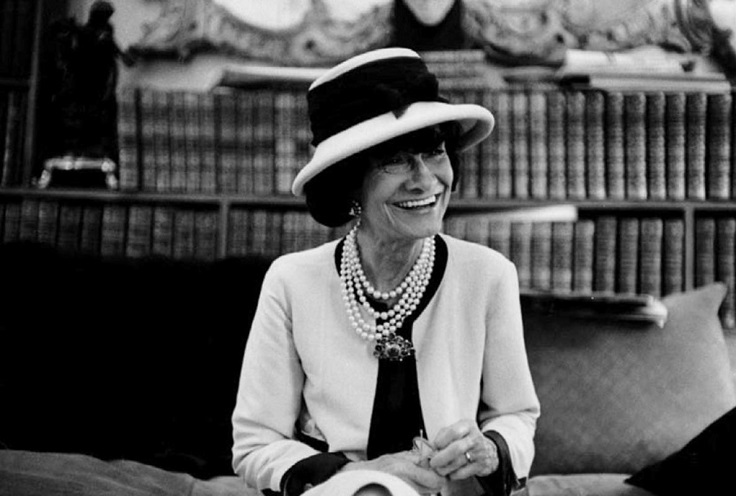Coco Chanel: the most revolutionary designer of 1900

Gabrielle Chanel was born in 1883. orphaned by her father, she was given in foster care to the Sisters of the Sacred Heart, in Aubazine. Surrounded by women dressed only in austere black and white dresses, Gabrielle begins to define the style she will bring to the world of fashion.
At the age of 18, she leaved the religious institute and began to work as a saleswoman and at the same time sings in a cafe. Hence the nickname Coco.
In a café in Moulins, she made the first of many important encounters that had studded her existence: she binded herself to Étienne de Balsan, the son of textile entrepreneurs with whom she entered into both a sentimental and a working relationship.

She was very good to making hats and, soon, the women who gravitate to Balsan’s company fell in love with him. Her highly sought-after creations leded her to move to Paris in 1908 and then to Deauville where, in ’14, she opened her first shops, followed in ’16 by a haute couture salon in Biarritz.
The fashion of the time was still closely linked to retrograde concepts: the corset, the crinoline, cages in which women locked themselves up to the cry of an aesthetic balance that was as sponsored as it was unhealthy. Thus, Chanel, always against the tide, always revolutionary, began to propose sporty models, with simple and soft lines, beyond any constraint and in line with the new health trend of the beginning of the century.
It was 1916 when Rodier, a French textile industrialist, exclusively gave her jersey, a fabric that proved to be the best interpreter of Chanel creations given its softness on the body and her innate ability to free the physicality of women. The skirt, pullover and cardigan triptych thus became the first distinctive model of Chanel fashion, made above all in non-colors such as gray, beige and dark blue as well as, of course, the combination of black and white, very dear to her style. But it was in 1920 that her consecration took place: this year, she opened her first boutique in Paris at 31 Rue de Cambon. And, from this moment, the road is downhill because success has definitely arrived, even if Coco Chanel is not a person to stop and, above all, to be satisfied.
She creates her first and famous perfume, Chanel N.5, a timeless fragrance that, even today, is considered one of the best ever conceived of her. Subsequently, other perfumes are born, such as N.22, Gardenia, inspired by the designer’s favorite flower that she will also present in costume jewelery, and N.19.
Always attentive, she observed the clothing of the Parisian office workers and salesmen, characterized by black dresses with white collars and cuffs. And it was in the mid-20s that this analysis was transformed into the petit robe noir, the little black dress with the simplest lines possible, capable of making every woman equal to the others, albeit with immense style. A democratic fashion, hers, which thanks to the proposal of the same models in which the fabrics and details are the variant of her is always faithful to her belief “fashion passes, style remains”.
A case in point of this vision is the absolute success achieved by the Chanel suit, loved by women all over the world: in gabardine, tweed and, of course, in jersey, a creation that is always the same as it is for the research of the cut and accuracy. of the seams, but not for the fabrics, always different, always in step with the times.
After shaping a stylistic vision of her, it’s time to think about accessories. Coco Chanel called Count Etienne de Beaumont and Duke Fulco di Verdura to her to start an atelier dedicated to jewelery creations in which non-precious gems are combined with the purest ones. Very rich, almost opulent creations, because if Coco loved the essentiality of the dress, she also wanted to combine it with whimsical accessories. And it is to be attributed to this period, the 1930s, the birth of the Chanel 2.55, which is the most copied bag in the world since the day it was created.

But Coco did not mind at all because, as she herself said,
“being plagiarized is the greatest compliment one can receive: it only happens to grown-ups.”
With the outbreak of the Second World War, Chanel is forced to retire from the fashion scene, but only for a while. Because her return, in ’54, sees her winning once again. Critics of the time gave her up for dead: they all await, with great joy, her imminent decline of her. But in her new N.5 collection she showed off the knitted suit, the one that will be worn by many women in the world, from the most famous to the least known. Among them also Jackie Kennedy who, on the day of the assassination of her husband JFK, wore just a Chanel suit in a bright pink point: high fashion was intertwined with one of the most dramatic events of the twentieth century.

On January 10, 1971, Chanel died in her suite at the Hôtel Ritz in Paris at the age of 87. Her life lived to the fullest, has forever changed international fashion and the concept of dressing the female body. Immediately following her death, the Maison was carried out by Gaston Berthelot and Ramon Esparza, assistants of the late designer. Later moving under the creative guidance of Karl Lagerfeld in 1983, the extraordinary designer demonstrated how to make the stylistic codes of the fashion house contemporary without ever betraying Chanel’s original vision.
